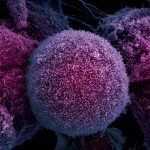Lien vers Pubmed [PMID] – 16177181
Nucleic Acids Res. 2005;33(16):5320-30
on-homologous end joining (NHEJ) and homologous recombination (HR) are pathways that repair DNA double-strand breaks (DSBs). In Saccharomyces cerevisiae, the repair of these breaks is influenced by histone acetylation. Therefore, we tested mammalian cells deleted for NHEJ (Ku80 or DNA Ligase IV) or altered for HR (breast cancer associated gene, Brca2, or Bloom’s syndrome, Blm) for sensitivity to trichostatin A (TSA), a histone deacetylase inhibitor that is being investigated as an anti-cancer therapeutic. We show that cells mutated for Ku80 (ku80-/-) or DNA Ligase IV (lig 4-/-), but not cells mutated for Brca2 (brca2lex1/lex2) or Blm (blm(tm3Brd/tm4Brd)), are hypersensitive to TSA in a dose-dependent manner. TSA-induced toxicity stimulates apoptosis and cell cycle checkpoint responses independent of p53, but does not increase phosphorylated histone H2AX (-H2AX) as compared with a clastogenic agent, camptothecin, indicating that the quantity of DSBs is not the primary cause of TSA-induced cell death. In addition, we show that potential anti-cancer drugs (LY-294002 and vanillin) that inhibit the family of phosphatidylinositol 3 kinases that include the NHEJ protein, DNA-PKCS act in synergy with TSA to reduce the viability of HeLa cells in tissue culture presenting the possibility of using the two drugs in combination to treat cancer.

